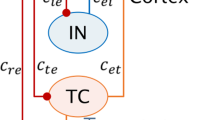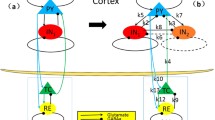Abstract
In the brain, feedforward inhibition is a fundamental regulator of balancing neural excitation and inhibition, and its dysfunction may cause epilepsy. In this paper, we investigate the influence of feedforward inhibition on absence seizures and its dynamical mechanisms based on a neural mass model. On the one hand, pyramidal neurons (PY), fast kinetic interneurons (\(I_{fast}\)) and slow kinetic interneurons (\(I_{slow}\)) form two feedforward inhibition pathways, which are the PY–\(I_{fast}\)–\(I_{slow}\) pathway and the PY–\(I_{slow}\)–\(I_{ fast}\) pathway, respectively. When changing the synaptic strength in different pathways, the system shows simple oscillation state, spike and wave discharge (SWD), and multi-spike and wave discharge (m-SWD). On the other hand, the one-parameter bifurcation analysis reveals that the system develops fold bifurcations, Hopf bifurcations, fold bifurcations on limit cycle, and period doubling bifurcations when state transitions occur. In particular, when the system is in the bistable region, the dynamic state of this region is closely related to the stable limit cycle and stable fixed point. Therefore, feedforward inhibition pathways are indeed involved in the regulation of absence seizures, excitatory connections in both feedforward inhibition pathways are more effective than the inhibitory connections in the control of absence seizures. More interestingly, the feedforward inhibition pathway PY–\(I_{slow}\)–\(I_{ fast}\) has a stronger regulation of absence seizures than PY–\(I_{fast}\)–\(I_{slow}\). These results provide a theoretical basis for a more detailed understanding of the underlying mechanisms of neurological disorders.
GraphicAbstract
















Similar content being viewed by others
Data Availability
The MATLAB, XPPAUT code and data that support the findings of this study are available from the corresponding author upon reasonable request.
References
R.M. Durón, M.T. Medina, I.E. Martínez-Juárez, J.N. Bailey, K.T. Perez-Gosiengfiao, R. Ramos-Ramírez, Seizures of idiopathic generalized epilepsies. Epilepsia 46, 34–47 (2005)
Yu, Y., Han, F., Wang, Q.: A hippocampal-entorhinal cortex neuronal network for dynamical mechanisms of epileptic seizure. IEEE Transactions on Neural Systems and Rehabilitation Engineering. (2023)
Mark A. Batzer, Prescott L. Deininger, Alu repeats and human genomic diversity. Nat. Rev. Genet. 3, 370–379 (2002)
J.T. Paz, J.R. Huguenard, Microcircuits and their interactions in epilepsy: is the focus out of focus. Nat. Neurosci. 18, 351–359 (2015)
N. Sah, S.K. Sikdar, Transition in subicular burst firing neurons from epileptiform activity to suppressed state by feedforward inhibition. Eur. J. Neurosci. 38, 2542–2556 (2013)
M. Chen, D. Guo, Y. Xia, D. Yao, Control of absence seizures by the thalamic feed-forward inhibition. Front. Comput. Neurosci. 11, 31 (2017)
D. Fan, L. Duan, Q. Wang, G. Luan, Combined effects of feedforward inhibition and excitation in thalamocortical circuit on the transitions of epileptic seizure. Front. Comput. Neurosci. 11, 59 (2017)
T. Arakaki, S. Mahon, S. Charpier, A. Leblois, D. Hansel, The role of striatal feedforward inhibition in the maintenance of absence seizures. J. Neurosci. 36, 9618–9632 (2016)
B.H. Jansen, V.G. Rit, Electroencephalogram and visual evoked potential generation in a mathematical model of coupled cortical columns. Biol. Cybern. 73, 357–366 (1995)
F. Wendling, F. Bartolomei, J.J. Bellanger, P. Chauvel, Epileptic fast activity can be explained by a model of impaired GABAergic dendritic inhibition. Eur. J. Neurosci. 15, 1499–1508 (2002)
O. David, K.J. Friston, A neural mass model for MEG/EEG: coupling and neuronal dynamics. Neuroimage 20, 1743–1755 (2003)
M. Ursino, F. Cona, M. Zavaglia, The generation of rhythms within a cortical region: analysis of a neural mass model. Neuroimage 52, 1080–1094 (2010)
F. Wendling, P. Benquet, F. Bartolomei, V. Jirsa, Computational models of epileptiform activity. J. Neurosci. Methods 260, 233–251 (2016)
B.S. Bhattacharya, D. Coyle, L.P. Maguire, A thalamo-cortico-thalamic neural mass model to study alpha rhythms in Alzheimer’s disease. Neural Netw. 24, 631–645 (2011)
F. Liu, J. Wang, C. Liu, H. Li, B. Deng, C. Fietkiewicz, K.A. Loparo, A neural mass model of basal ganglia nuclei simulates pathological beta rhythm in Parkinson’s disease. Chaos 26, 123113 (2016)
R.L. Beurle, Properties of a mass of cells capable of regenerating pulses. Philos. Trans. R. Soc. Lond. Ser. B Biol. Sci. 2, 55–94 (1956)
F.H. Lopes da Silva, A. Hoeks, H. Smits, L.H. Zetterberg, Model of brain rhythmic activity: thealpha-rhythm of the thalamus. Kybernetik 15, 27–37 (1974)
M.S. Costa, J. Born, J.C. Claussen, T. Martinetz, Modeling the effect of sleep regulation on a neural mass mode. J. Comput. Neurosci. 41, 15–28 (2016)
R. Becker, S. Knock, P. Ritter, V. Jirsa, Relating alpha power and phase to population firing and hemodynamic activity using a thalamo-cortical neural mass model. PLoS Comput. Biol. 11, e1004352 (2015)
S. Geng, W. Zhou, Influence of extrinsic inputs and synaptic gains on dynamics of Wendling’s neural mass model: A bifurcation analysis. J. Integr. Neurosci. 15, 463–483 (2016)
Z. Shen, Z. Deng, L. Du, H. Zhang, L. Yan, P. Xiao, Control and analysis of epilepsy waveforms in a disinhibition model of cortex network. Nonlinear Dyn. 103, 2063–2079 (2021)
M. Goodfellow, K. Schindler, G. Baier, Intermittent spike-wave dynamics in a heterogeneous, spatially extended neural mass model. Neuroimage 55(3), 920–932 (2011)
F. Marten, S. Rodrigues, P. Suffczynski, M.P. Richardson, J.R. Terry, Derivation and analysis of an ordinary differential equation mean-field model for studying clinically recorded epilepsy dynamics. Phys. Rev. E 79(2), 021911 (2009)
H.J. Pi, B. Hangya, D. Kvitsiani et al., Cortical interneurons that specialize in disinhibitory control. Nature 503(7477), 521–524 (2013)
D. Fan, Q. Wang, M. Perc, Disinhibition-induced transitions between absence and tonic-clonic epileptic seizures. Sci. Rep. 5, 12618 (2015)
F. Grimbert, O. Faugeras, Bifurcation analysis of Jansen’s neural mass model. Neural Comput. 18, 3052–3068 (2006)
Acknowledgements
This work was supported by the National Natural Science Foundation of China (Grant Nos.12001001 and 12272002) and “Yujie Team” project of North China University of Technology (No. 107051360022XN725). The authors would like to thank all the reviewers for their valuable comments.
Author information
Authors and Affiliations
Contributions
Both authors contributed equally to the present work, were equally designed the study, carried out the computations, analyzed the results, and proofread the results.
Corresponding author
Rights and permissions
Springer Nature or its licensor (e.g. a society or other partner) holds exclusive rights to this article under a publishing agreement with the author(s) or other rightsholder(s); author self-archiving of the accepted manuscript version of this article is solely governed by the terms of such publishing agreement and applicable law.
About this article
Cite this article
Wang, Z., Xie, M. Kinetic analysis of spike and wave discharge in a neural mass model. Eur. Phys. J. B 96, 94 (2023). https://doi.org/10.1140/epjb/s10051-023-00565-4
Received:
Accepted:
Published:
DOI: https://doi.org/10.1140/epjb/s10051-023-00565-4




